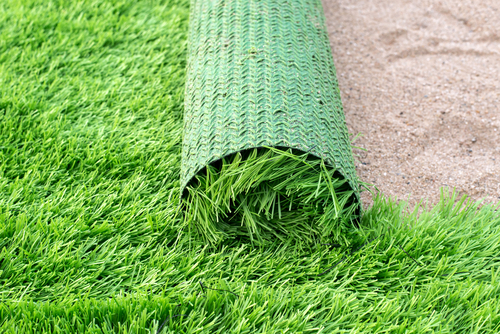Former Toronto City Councillor Karen Stintz has a perfect, manicured green lawn. It’s not because she’s using pesticides or herbicides, or spending hours tending to it – it’s made from artificial turf.
At first glance, it might not seem like such a crazy idea – artificial turf doesn’t need watering or cutting, and it looks green and healthy even in January. So should we all be rushing to tear out our grass and replace it with sheets of plastic?
If you live in the City of Toronto, you definitely shouldn’t – it’s a violation of city bylaws. Though those with fake lawns might see it as unfair, there are several reasons why converting grass to plastic isn’t a good idea for people or for cities.
- Urban heat island effect. Unlike grass, which has a cooling effect, artificial turf gets as hot as asphalt and contributes to this problem.
- Damage to aquatic ecosystems. Artificial turf is made from infill materials, such as crumb rubber from recycled tires, to help the plastic blades of grass stand upright. When it is disturbed, by people or animals walking on it, or by stormwater flow, these crumbs are dislodged and can be washed off into storm sewers. Plastic pollution is becoming an increasing concern in the Great Lakes and beyond.
- Possible health impacts. The crumb pellets that wash off the surface of artificial turf can also find their way onto the bodies of people and animals in contact with it. Toronto Public Health recommends that people should avoid eating on artificial turf and that all pellets should be cleaned from shoes and clothing before exiting fields. The effect of these pellets on human health is unclear, as are the potential impacts on animals and aquatic life.
- Increased flooding. Unless specifically designed to absorb runoff (for example with a granular water storage layer underneath), artificial turf can contribute to increasing localized flooding during extreme weather events by prohibiting infiltration.
- Reduced green space. Artificial turf may look green, but it doesn’t provide any of the ecosystem services that real grass or gardens provide, including carbon sequestration, food and habitat for birds and insects, and maintaining soil health. By compressing soil volumes, artificial turf can impact the health of neighbouring trees.
- Maintenance. It’s not as carefree as it looks – artificial lawns need to be vacuumed and washed regularly, in order to remove debris and animal waste. They also require replacement at regular intervals, depending on the level of use.
A study by Toronto Public Health concluded that, in some cases, for sports fields, the benefits of artificial turf may outweigh the risks, and that “in cases where the use of natural turf is not possible or practical”, artificial turf may be a good option because of the benefits of increased physical activity. This doesn’t mean that it makes sense for lawns. Do we really need perfect lawns in January when they come with all these risks?


